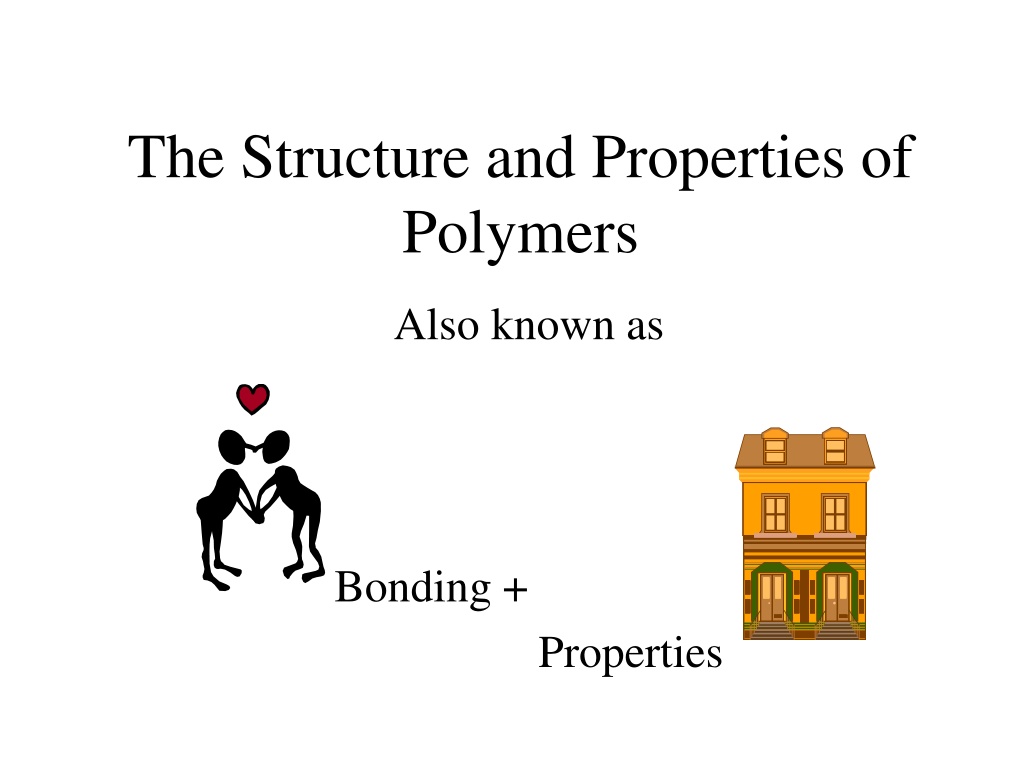Understanding Polymers: Structure, Properties, and Design Considerations
Explore the world of polymers, from the basics of polymer structure and properties to the intricacies of copolymerisation and thermoplastics. Dive into the role of molecular structures in determining polymer properties and discover the diverse applications of elastomers, plastics, and fibres in our daily lives.
Download Presentation

Please find below an Image/Link to download the presentation.
The content on the website is provided AS IS for your information and personal use only. It may not be sold, licensed, or shared on other websites without obtaining consent from the author. Download presentation by click this link. If you encounter any issues during the download, it is possible that the publisher has removed the file from their server.
E N D
Presentation Transcript
The Structure and Properties of Polymers Also known as Bonding + Properties
What is a polymer? A long molecule made up from lots of small molecules called monomers.
All the same monomer Monomers all same type (A) A + A + A + A -A-A-A-A- eg poly(ethene) polychloroethene PVC
Different monomers Monomers of two different types A + B A + B + A + B -A-B-A-B- eg polyamides polyesters
Addition polymerisation Monomers contain C=C bonds Double bond opens to (link) bond to next monomer molecule Chain forms when same basic unit is repeated over and over. Modern polymers also developed based on alkynes R-C C - R
Copolymerisation when more than one monomer is used. An irregular chain structure will result eg propene/ethene/propene/propene/ethene Why might polymers designers want to design a polymer in this way? (Hint) Intermolecular bonds!
Elastomers, plastics & fibres Find a definition and suggest your own example of each of these.
What decides the properties of a polymer? Stronger attractive forces between chains = stronger, less flexible polymer. Chains able to slide past each other = flexible polymer . In poly(ethene) attractive forces are weak instantaneous dipole - induced dipole, will it be flexible or not? Nylon has strong hydrogen bonds, why does this make it a strong fibre?
Getting ideas straight Look at page 110 -111 of Chemical Ideas. Take turns in explaining to a partner how the following molecular structures affect the overall properties of polymers :- chain length, different side groups, chain branching, stereoregularity, chain flexibility, cross linking.
Thermoplastics (80%) No cross links between chains. Weak attractive forces between chains broken by warming. Change shape - can be remoulded. Weak forces reform in new shape when cold.
Thermosets Extensive cross-linking formed by covalent bonds. Bonds prevent chains moving relative to each other. What will the properties of this type of plastic be like?
Longer chains make stronger polymers. Critical length needed before strength increases. Hydrocarbon polymers average of 100 repeating units necessary but only 40 for nylons. Tensile strength measures the forces needed to snap a polymer. More tangles + more touching!!!
Crystalline polymers Areas in polymer where chains packed in regular way. Both amorphous and crystalline areas in same polymer. Crystalline - regular chain structure - no bulky side groups. More crystalline polymer - stronger and less flexible.
Cold-drawing When a polymer is stretched a neck forms. What happens to the chains in the neck ? Cold drawing is used to increase a polymers strength. Why then do the handles of plastic carrier bags snap if you fill them full of tins of beans?
This powerpoint was kindly donated to www.worldofteaching.com http://www.worldofteaching.com is home to over a thousand powerpoints submitted by teachers. This is a completely free site and requires no registration. Please visit and I hope it will help in your teaching.


































